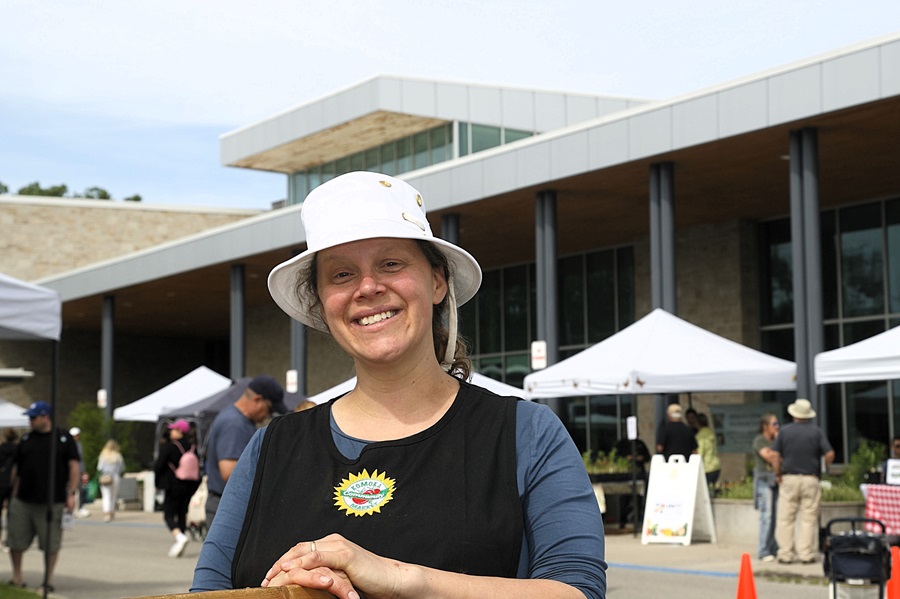Rooting the community
A passion project turned business, the Komoka Community Market plays a vital role for vendors, consumers and community
Photo: Amy Watt of the Komoka Community Market
AMY WATT GREW up on a vegetable farm, and when she found herself “in a time of reflection in my life,” she says she started growing produce and selling a little bit at local farmers’ markets.
Click here to view this story in magazine format
It was at those markets that she noticed something: some of those farmers she was selling alongside weren’t farmers at all. “They would pick up their stuff at the food terminal, come to the market and pose as farmers,” says Watt. “They had all the right lingo that people wanted to hear — homegrown vegetables and things like that, but they weren’t farmers.”
Story Continues Below
This experience was forefront in her mind in 2018, when Watt and her husband decided to start the Komoka Community Market. More than anything, the couple wanted to do it right.
“We stuck to the priorities of quality and only local producers,” she says. “We had a lot of resellers apply; we didn’t accept any of them. We really realized that this is important — for all things to be local, made with local sources and to be really helping the small local economy.”

Those principles — and their adherence to them — were put to the test over the first two “super slow” years, says Watt.
And then the pandemic came along. Forced to deal with uncertainty and mandatory closures (back in 2020, markets were deemed non-essential and had been forced to close), many regional farmers’ markets scaled back or ceased operating altogether. “We really had to make a decision: are we going to invest in all the signage, barriers and all these things that we’re required to have?” Watt recalls.
The couple opted to invest the money to keep going — just as several other markets in the area went the other way. Meanwhile, the produce in the fields was still growing and the crafters were still crafting.
“So, all of the sudden we had a lot of applicants who had vegetables, produce and crafts to sell and didn’t have anywhere to sell them,” Watt explains. “Our pickiness was a huge problem before, but now we could be a little pickier and it became really evident that that was what was creating a good culture and vibe. And that has just grown and grown since then.”
“It’s not just a market; it’s a community space where so many people are involved in bringing it more life, more culture” —Amy Watt
Today, the Komoka Community Market has swelled from a dozen or so vendors to between 50 and 60, plus local musicians, and they have about a thousand people come through the market on an average Saturday morning (the market runs 9 a.m. to noon on Saturdays from Victoria Day weekend to Thanksgiving weekend). Many vendors say it’s their best and most profitable market, and it’s become a mainstay on many people’s weekend calendars in the city’s west end.
“The Komoka Community Market is the best outdoor farmers’ market in the London area,” says Sean Hannam of Artisan Bakery, located in Old East Village. “We have seen great success attending that market. The organizers do a great job of filling the booths, and customers in that area are very excited to have quality foods available.”
Undoubtedly, the market has certainly been helped by the explosive growth of the city’s west side, and much of its foot traffic comes from the Komoka, Kilworth and RiverBend communities. But it’s drawing city folk, too. Despite alternatives closer to home, Watt says that they see a good chunk of traffic driving out to Komoka from the city. Vendors, too. “They’ll come, and a lot of their customer base will follow them,” she says.

“It’s really become a launch pad for young entrepreneurs, businesses and musicians,” Watt says. “It’s not just a market; it’s a community space where so many people are involved in bringing it more life, more culture. I think in that way, it’s kind of taken on a life of its own.”
For Watt and her husband, thinking about the future of the market is more a matter of wondering where the market will take them, rather than the other way around. “I don’t really have any goals beyond what we’re doing — and I haven’t for the last three years, really. It just seems to grow because community involvement grows,” Watt says.
Story Continues Below
More than anything, it’s that community enthusiasm that drives and shapes the market and its place in the community — even during trying intervals.
“There have been a few times when I’ve said to my husband, ‘We’re not doing it anymore.’ And then inevitably somebody comes along the next day and says something like, ‘I want to take over your social media — you shouldn’t have to do that anymore.’ It’s happened so many times. It’s like all these miracles happen around the market.” ![]() Kieran Delamont
Kieran Delamont

